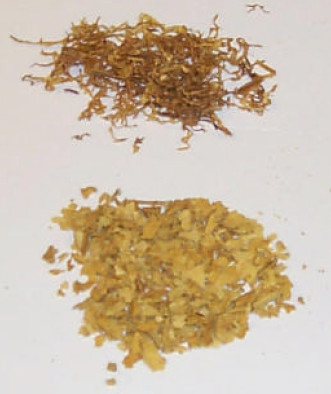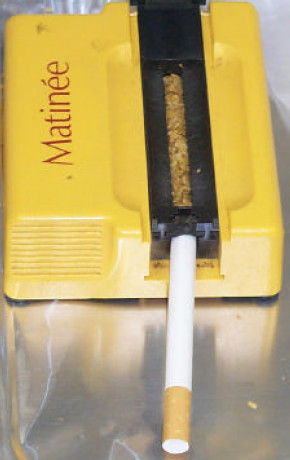Preparation of Cigarettes from Packaged Leaf Tobacco for Testing
Health Canada
T-401 December 31, 1999
Table of Contents
- Scope Of Applications
- Normative references
- Definitions
- Method Summary
- Apparatus and Equipment
- Sampling
- Sample Processing
- References
1 Scope Of Applications
- Applicable to the preparation of processed, and cured commercially available whole tobacco leaf for incorporation into cigarettes.
2 Normative References
- Health Canada Test Method T-115 – Determination of Tar, Water, Nicotine and Carbon Monoxide in Mainstream Tobacco Smoke, 1999-12-31.
- CAN/CGSB-176.1-92 – Preparation of Cigarettes from Cigarette Tobacco for Testing. National Standard of Canada. Canadian General Standards Board. Appendix A, December 1992.
-
International Organization for Standardization (ISO) Method
- ISO 4387:1991 Cigarettes – Determination of total and nicotine-free dry particulate matter using a routine analytical smoking machine, 1991-10-15.
3 Definitions
- Refer to T-115 for definitions of terms used in this document.
4 Method Summary
- Whole tobacco leaf is dissected using a utility knife in order to separate the midrib from the lamina. The midrib is discarded while the top third of the leaf (tip) and the lamina are added to a Robot Coupe batch processor or equivalent.
- 75 g of the dissected tobacco (lamina + tip) are subject to maceration at 3000 rpm for six minutes. The resulting chopped tobacco is then sieved through a 4 mm, and 850 µm sieve for 30 seconds. Tobacco retained by the 4 mm sieve, and tobacco that has passed through the 850 µm sieve, is discarded.
- The tobacco retained by the 850 m sieve is then spread in a monolayer (2 – 4 mm thick), onto aluminum sheets, and conditioned as specified in T-115.
-
The cigarettes are made using a hand-operated cigarette-making device (e.g. Matinee Filter Master or equivalent) to inject 900 ± 10 mg of the conditioned samples of tobacco into the cigarette tube to a uniform packing density.
The number of cigarettes to be prepared shall be determined using ISO 4387:1991 as
a guide.
Note: The testing and evaluation of certain products against this test method may require the use of materials and or equipment that could potentially be hazardous and this document does not purport to address all the safety aspects associated with its use. Anyone using this test method has the responsibility to consult with the appropriate authorities and to establish health and safety practices in conjunction with any existing applicable regulatory requirements prior to its use.
5 Apparatus and Equipment
- Utility knife.
- Hard Surfaced Cutting Board.
- Robot Coupe RSI 2V Batch Processor (or equivalent).
- USA Standard Testing Sieve (A.S.T.M.E.-11) – 4.00 mm (0.157”) No. 5.
- USA Standard Testing Sieve (A.S.T.M.E.-11) – 850 um (0.0331”) No. 20.
- Aluminum pan or cookie sheet.
- Weighing paper.
- Analytical Balance capable of measuring to four decimal places.
- Matinee Filter Master (or equivalent).
- Cigarette tubes.
- Equipment needed to perform conditioning as specified in T-115.
6 Sampling
- The sampling of tobacco for this procedure shall be according to CAN/CGSB- 176.1-92, Appendix A.
7 Sample Processing
- Dissection of Whole Leaf Tobacco
- Place a single whole leaf of tobacco onto a cutting board.
- Dissect the leaf by first cutting the top 1/3 of the leaf (tip), and then
remove the lamina from the midrib by cutting along both sides of the midrib
from the remaining 2/3 of the leaf (see illustration below).
The following figure contains a set of comparison photos for the initial tobacco leaf on the left to the dissected leaf on the right. The leaf was first cut horizontally to give 2 pieces, and the bottom half was further cut vertically, resulting in a total of 3 fragments.

- Discard the midrib portion of the dissected leaf.
- Place a total of 75 ± 5 g of the dissected lamina (tip + lamina) into the Robot Coupe batch processor.
- Maceration of Tobacco
- Secure lid of Robot Coupe batch processor.
- Set the processor to 3000 rpm.
- Turn the unit on and process the sample for a total of six minutes at 3000 rpm.
- Sieving of Processed Tobacco
- Assemble the sieving apparatus from bottom to top as follows: Collection pan, 850 µm sieve, 4 mm sieve.
- Pour the processed tobacco sample from the batch processor container into the sieve.
- Place the lid onto the sieve and shake in a back and forth motion for 30 seconds.
- Remove lid from the sieve and discard any tobacco retained by the 4 mm sieve.
- Pour the tobacco sample retained by the 850 µm sieve onto an aluminum sheet.
- Discard remaining tobacco from the sieve.
-
The processed tobacco should appear similar to the following.
The following figure displays a comparison of the processed leaf tobacco (at the bottom) to normal fine cut tobacco (at the top). The fine cut tobacco is in longer and fragmented pieces, while the processed leaf tobacco is in flat chunks.

- The above shows a comparison of processed leaf tobacco (bottom) to normal fine cut tobacco (top).
- Conditioning of Tobacco
- The tobacco retained by the 850 µm sieve is spread in a monolayer (2 – 4 mm thick), onto aluminum sheets.
- The tray is placed into a controlled environment room (CER) at 22 ± 1°C and 60 ± 2 % relative humidity (RH) for 48 hours to condition as specified in T-115.
- Preparation of Cigarettes for Testing
- Weigh 0.900 ± 0.01 g of conditioned tobacco onto weigh paper using a four decimal place balance.
- Transfer the tobacco to the Matinee Filter Master such that there is an even distribution of tobacco in the trough.
-
Place the cigarette tube onto the Filter Master (see illustration below).
The following figure contains a photo of tobacco inserted into a filter master through a hole and cigarette tube.

- Close the top of the filter master to load the tobacco into the cigarette tube as per the instructions.
- Carefully remove the cigarette from the filter master as to not lose tobacco from the tip.
- Cigarettes are marked for butt length as specified in T-115.
- The prepared cigarettes are conditioned as specified in T-115.
8 References
- Protocol to Measure the Quantity of Nicotine Contained in Smokeless Tobacco Products Manufactured, Imported, or Packaged in the United States, Federal Registrar, Vol. 62, No. 85, Friday, May 2, 1997. p. 24115 - 24117.